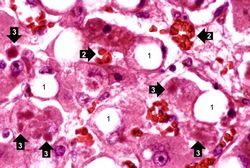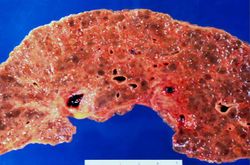IPLab:Lab 2:Fatty Change and Cirrhosis
Contents
Clinical Summary[edit]
This 54-year-old man with a long history of alcohol abuse had been admitted to the hospital numerous times for abdominal pain thought to be due to gastritis or a peptic ulcer. On several occasions his serum amylase level was elevated into the range of 300-500 u/L indicating relapsing or recurrent pancreatitis. Three weeks prior to his demise, the patient began an alcoholic binge. The binge continued until three days prior to the patient's death at which time he developed fever and malaise, prompting him to cease drinking. He was brought to the hospital semi-comatose and with a fever of 105.4°F. Shortly after arriving at the hospital, the patient died from massive pneumonia.
Autopsy Findings[edit]
At autopsy, a necrotizing lobar pneumonia was present which contained organisms consistent with Klebsiella pneumoniae. The liver was enlarged--weighing 2700 grams--and had a yellow-orange color. The liver was firm to palpation and the cut surface had a slightly granular appearance suggestive of early cirrhosis. The pancreas showed multiple areas of fibrosis.
Images[edit]
A high-power photomicrograph of the liver parenchyma shows that each individual liver cell is filled with a large, clear droplet which represents the space remaining after lipid was dissolved by the dehydration procedure used to embed the tissue. Note that each empty space is surrounded by a thin rim of eosinophilic cytoplasm; in many instances, the hepatocyte nucleus can be seen as well. The red body (arrow) seen within a cell in the center of the slide is an acidophilic body associated with alcoholic hepatitis.
An oil red O stain for fat was performed on a frozen section of this liver tissue. The red droplets represent fat in the tissue which is typical of fatty degeneration in the liver. By using frozen sections the tissues do not have to be dehydrated through alcohol solutions and thus the fat does not get washed out.
This photomicrograph of the liver is from another patient with a history of alcohol use. There are some clear vacuoles indicating fat droplets (1) and there are numerous red-staining granular deposits within the cytoplasm of hepatocytes (3)this is alcoholic hyalin. Alcoholic hyalin is easily distinguished from red blood cells (2) that are also present in this section.
This is a low-power photomicrograph of liver stained with a trichrome stain. In this section, connective tissue stains green (arrows) and hepatic parenchymal cells are red. Note that many of the parenchymal cells have clear spaces indicating fatty degeneration. The proliferation of scar tissue between the liver lobules is the result of cirrhosis.
Virtual Microscopy[edit]
Liver: Fatty Change and Cirrhosis[edit]
Normal Liver[edit]
Study Questions[edit]
Additional Resources[edit]
Reference[edit]
- eMedicine Medical Library: Cirrhosis
- eMedicine Medical Library: Alcoholic Hepatitis
- Merck Manual: Alcoholic Liver Disease
- Merck Manual: Cirrhosis
Journal Articles[edit]
- Satapathy SK, Narayan S, Varma N, Dhiman RK, Varma S, Chawla Y. Hyposplenism in alcoholic cirrhosis, facts or artifacts? A comparative analysis with non-alcoholic cirrhosis and extrahepatic portal venous obstruction. J Gastroenterol Hepatol 2001 Sep;16(9):1038-43.
Images[edit]
Related IPLab Cases[edit]
| |||||
A normal PaCO2 is 35 to 45 mmHg.
Gastritis is inflammation of the stomach.
A normal serum amylase level is 30 to 110 u/L.
Chronic inflammation of the pancreas (pancreatitis) is most often caused by alcoholism or biliary tract calculi.
In alcoholics, aspiration pneumonia is common--bacteria enter the lung via aspiration of gastric contents.
Necrotizing lobar pneumonia is a severe acute pneumonia caused by virulent organisms and aspirated of gastric contents.
A normal liver weighs 1650 grams (range: 1500 to 1800 grams).
Cirrhosis is a liver disease characterized by necrosis, fibrosis, loss of normal liver architecture, and hyperplastic nodules.
Nodular hyperplasia of the prostate--characterized by large discrete prostatic nodules--is a common disorder in men over 50 years of age. The nodules cause the prostate to be enlarged and to have an increased weight. The human prostate is surrounded by a restrictive capsule. These nodules cause increased pressure within the capsule which leads to constriction of the urethra as it passes through the prostate. Urethral constriction leads to retention of urine.











